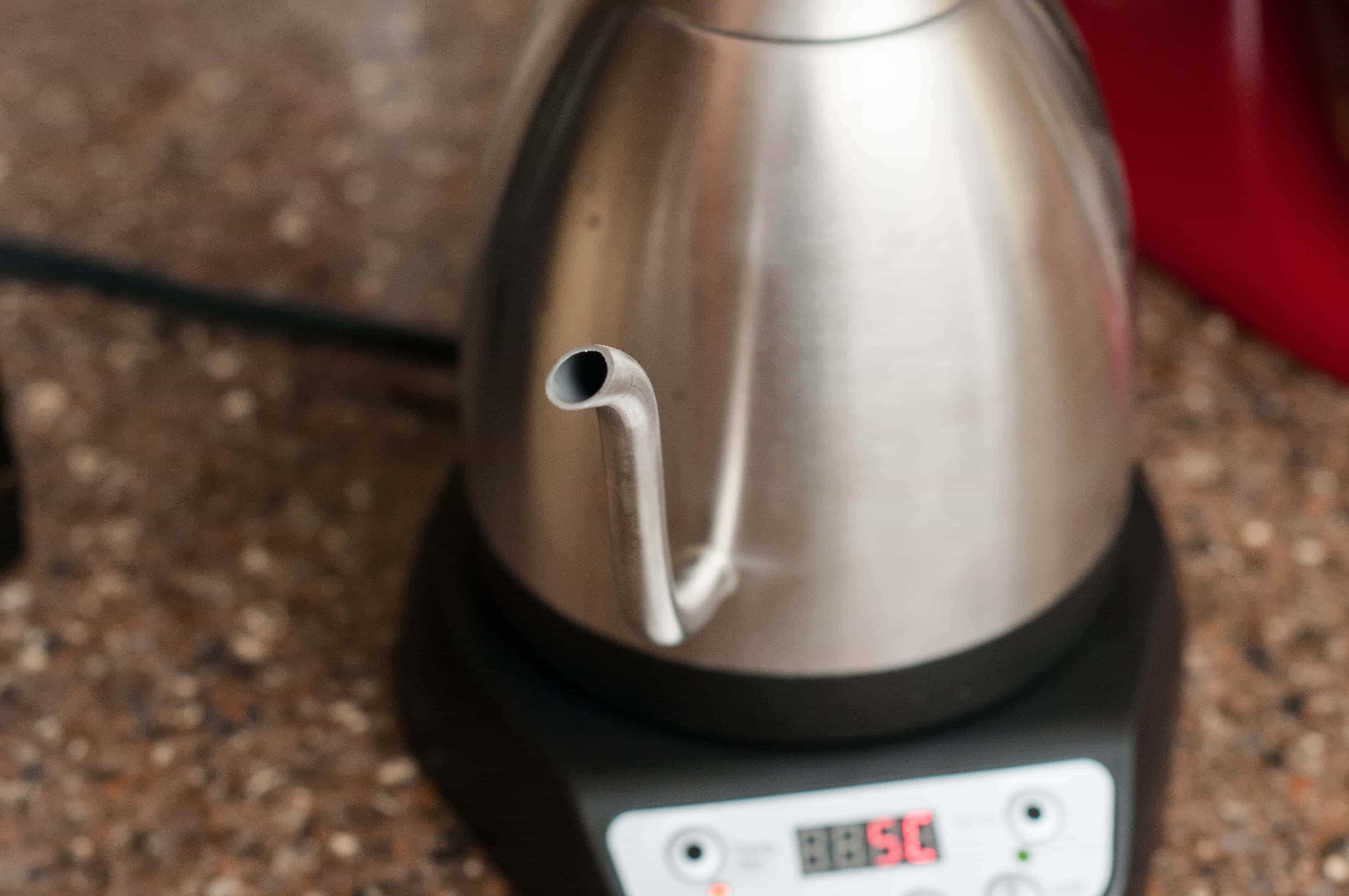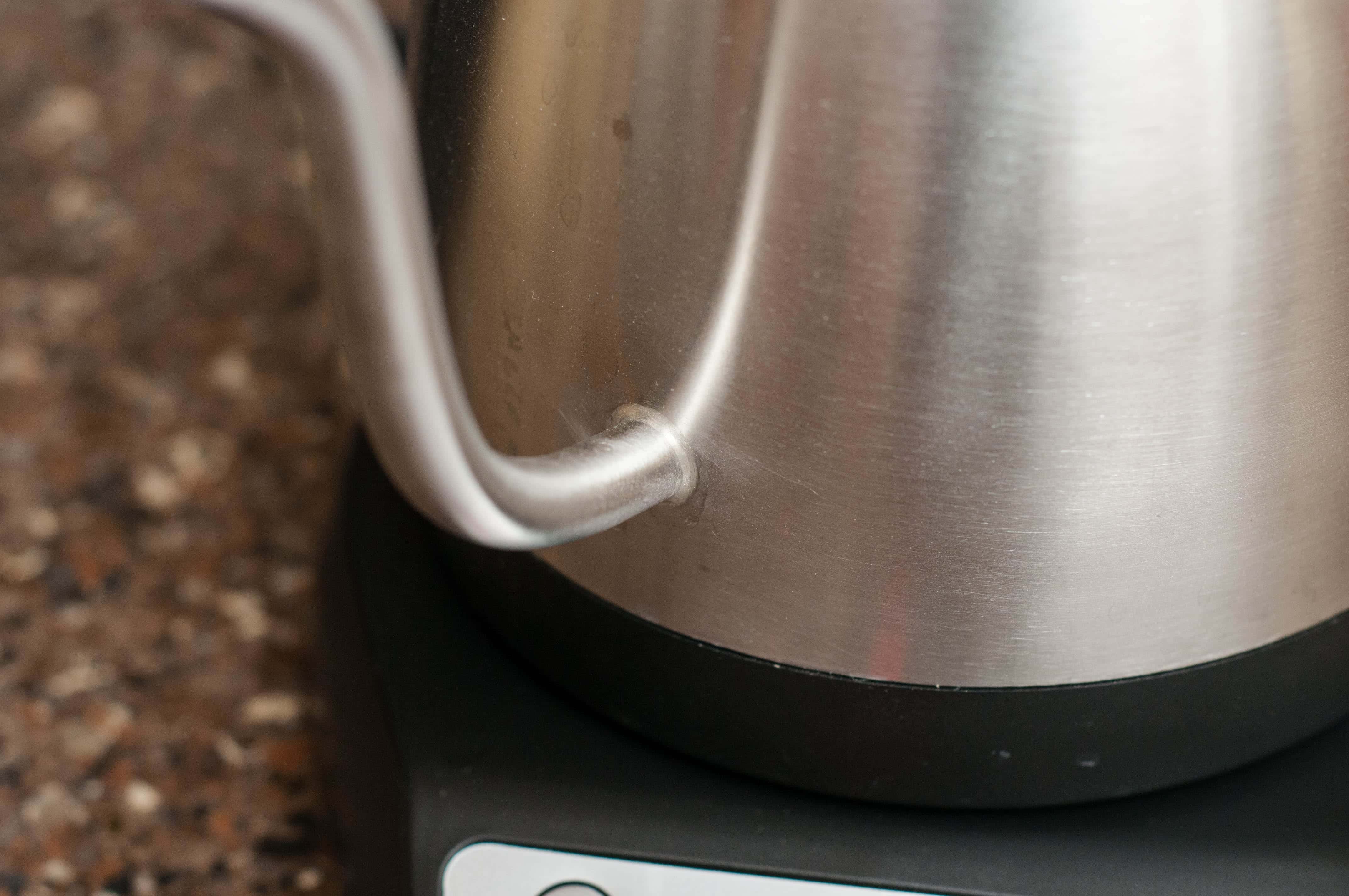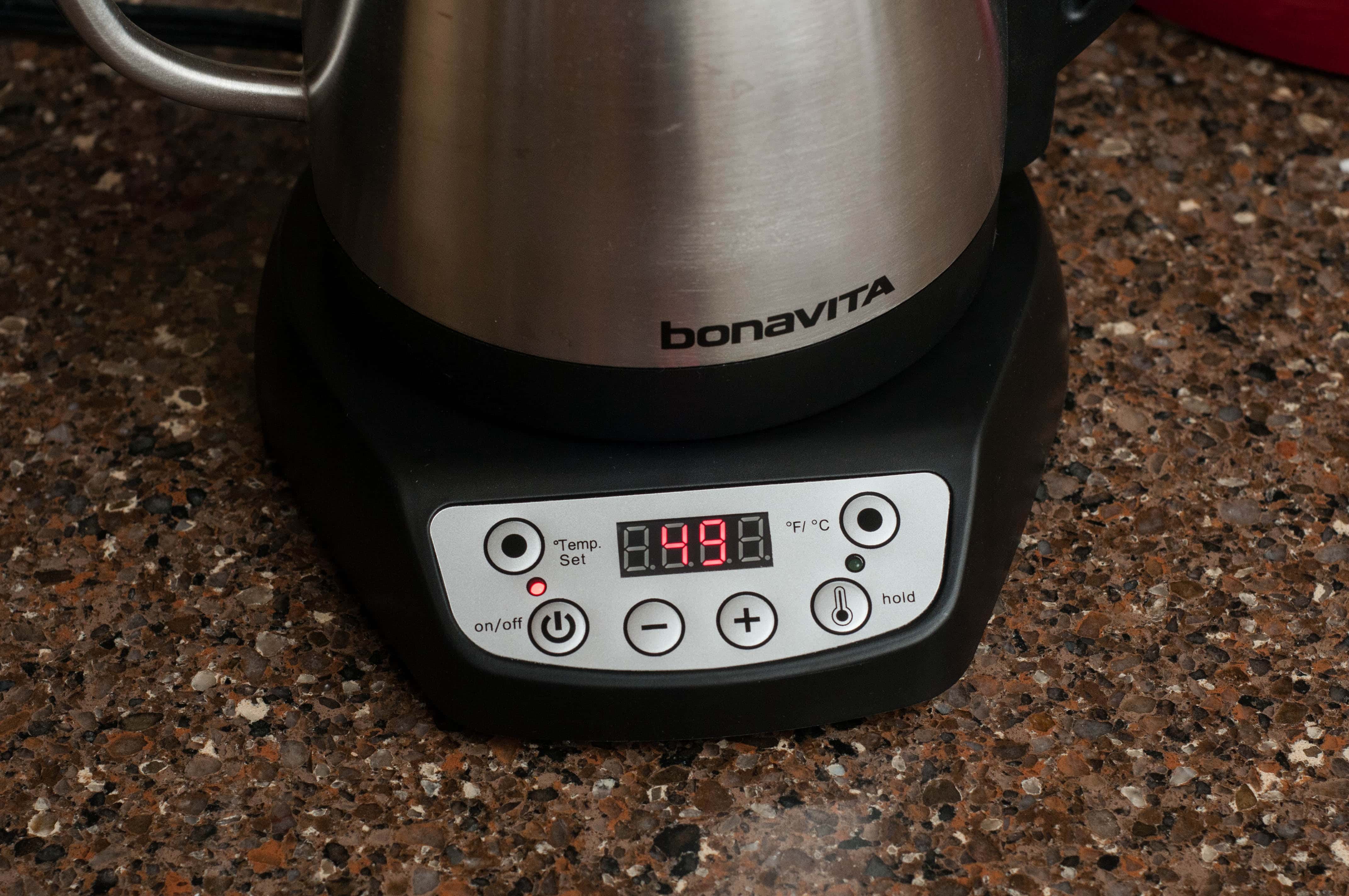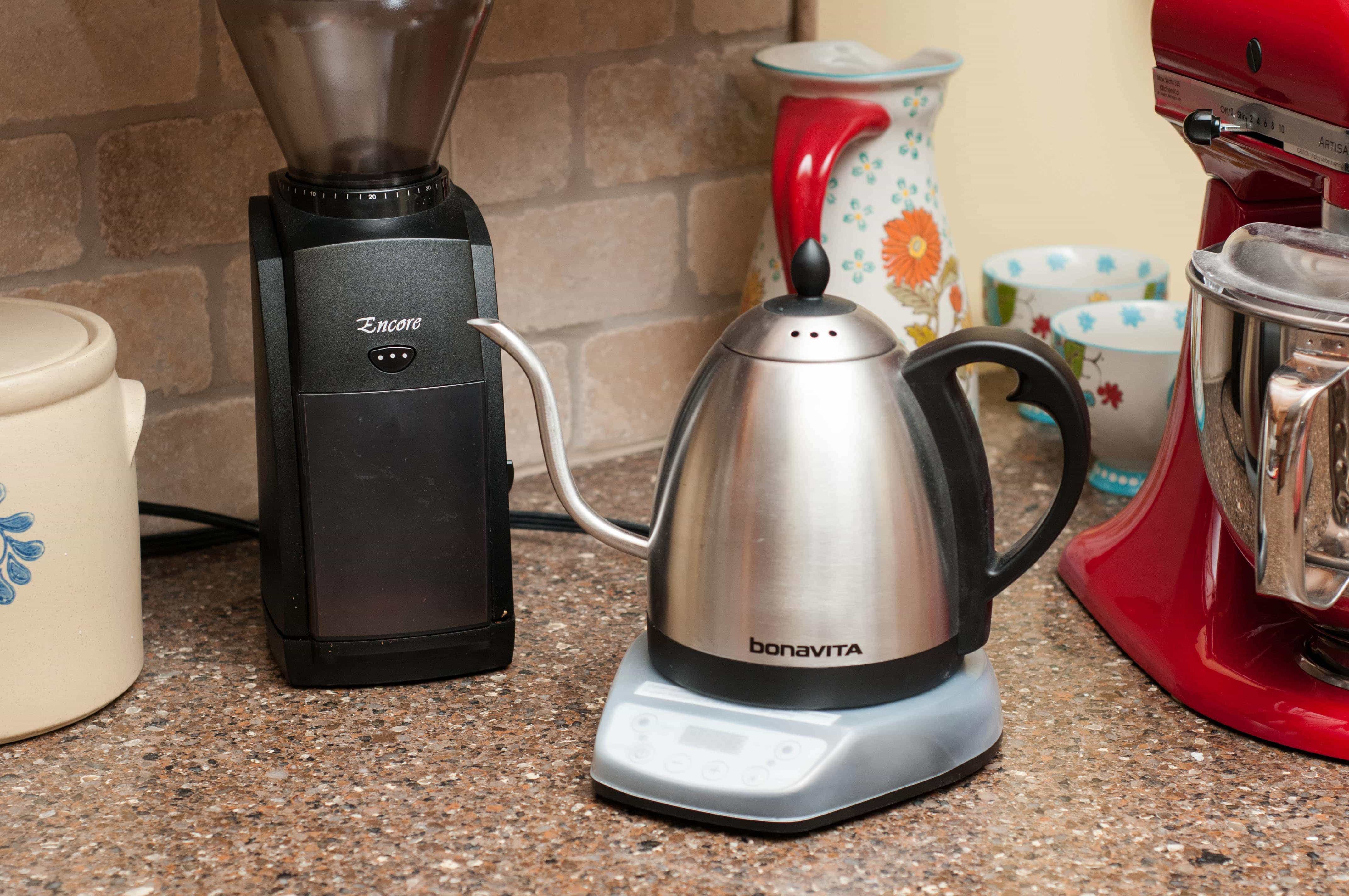Dipping one’s toes into the world of coffee nerdery for the first time can feel so overwhelming. There’s a lot to think about: essential gear, brewing methods, coffee bean sourcing, tasting notes, artisanal canvas aprons…
Okay, that last one was a joke, but people do take this stuff pretty seriously. Given the chance, many self-styled “baristas” out there will gladly give a dissertation on why your way of making coffee sucks and theirs is the best. But there’s one thing they almost all agree on: Everyone’s coffee kit should have a gooseneck kettle.
Back in 2011, Oliver Strand of The New York Times described what makes a gooseneck so great (bold emphasis mine):
The narrow spout produces a thin, precise stream, and the handle brings your hand into a naturally balanced position — instead of flooding the filter and letting it drip, you deliver a measured amount of water over a period of several minutes. It might sound precious or tedious, but the control is enthralling. It’s like picking up a drafting pen after only writing with Magic Markers.
It’s hard to put it better than that. Whether you’re brewing with an AeroPress, a pour-over contraption like the Hario V60 dripper, or the larger Chemex, a gooseneck kettle offers the ultimate pouring control and precision.
The Review
Bonavita’s variable-temp gooseneck kettle is one we’ve mentioned a lot around here at Tools & Toys. It made the cut for our 2014 Christmas Catalog and we consider it an essential piece of kitchen gear. One thing we’ve never done though is give an in-depth review about why it’s so great. That changes today.
Let’s clear up right now that if you just want something that makes water hot for you, any old kettle will get you by just fine. Heck, you can get the variable-temp’s non-adjustable counterpart and save yourself $26, or maybe pick up a classic-style whistling kettle on the cheap. If you’re not going to fiddle with your coffee brewing, the variable-temp isn’t for you.

The gooseneck spout is the hallmark feature of the variable-temp kettle, allowing for better precision and accuracy when pouring boiling water into your favourite coffee brew kit.

The stainless steel kettle can get extremely hot when boiling water.


The top lid of the Bonavita variable-temp gooseneck kettle.
However, if you do want to experiment a bit — or maybe follow some fancy AeroPress recipes to the letter — then you’ll love the variable-temp kettle.
Note: For this review, we will only be discussing the 1-liter version of the gooseneck kettle, which usually hovers in the $80–$85 price range. They also offer a larger 1.7-liter version that we’ve seen sell for anywhere from $95 to $160, but we haven’t tested that one so much. The performance is probably similar (especially since they share the exact same heating unit/base), but we make no guarantees at this time.
The Good
There’s a lot to love about this thing. Let’s break it down.
Temperature Control
To start with, the kettle comes with six preset temperatures that you can switch between by pressing the “Temp Set” button:
- 140°F / 60°C
- 176°F / 80°C
- 185°F / 85°C (the factory default)
- 190°F / 88°C
- 205°F / 96°C
- 208°F / 98°C
But, the real magic lies in its ability to heat to any temperature you set, in one-degree increments, all the way up to boiling (212°F / 100°C). Simply press the “Temp Set” button on the kettle’s base/heating element, and while the display is flashing, press the + or - button until you get the temperature you want. To make things go a little faster, you can switch to any of the presets listed above first and adjust from there.

If you press the “Temp Set” button on the left, you can manually choose any temperature up to 212°F / 100°C and have the kettle bring the water to your desired temperature at the press of a single button.
Whatever temp you set is stored in memory and recalled the next time you turn the kettle on, even a year later. Once it heats water to the set temperature, the kettle shuts off automatically — that is, unless you’ve pressed the “Hold” button to have the kettle maintain that temperature (give or take a degree or two) for an hour. This function works by continually turning the heating element on and off as needed.
A couple notes about the “Hold Temperature” function:
- You can set it to hold your desired temperature during the numeric selection, while the display is flashing (either when you’ve first turned the kettle on, or after pressing the “Temp Set” button). When I first got my kettle, I would stand nearby while it heated and wait to hit “Hold” when the correct temperature came up. Silly of me.
- If you’ve activated the “Hold” feature, lifted the kettle to pour, and returned it to the base, the kettle will not automatically continue the “Hold Temperature” function unless you hit the button again within five seconds. If you do miss the five-second rule, don’t worry. Simply turn the power back on and hit the “Hold” button while the display is flashing, just like you did at the start.
There’s also a button on the base that switches between °F and °C modes. This is certainly convenient, though you’ll probably only ever use it once unless you really enjoy checking what the current temperature is on the other scale before switching back.
Temperature Accuracy
If you open the kettle’s lid and look inside, you’ll see a tiny metal rod sticking out of the bottom. That’s the thermocouple that tells the base what temperature the water is at any given time, and it’s very accurate.
The way it achieves accuracy within a degree or two of your desired temperature, every single time, is that as the kettle heats and reaches 10°F below the temp you’ve set, it begins “pulsing” the heating element off and on until it sort of eeeeeeases up to that temperature. You’ll hear some repeated clicking as it goes through this process, which is totally normal.
The Rest
Here are a few more great things that don’t require sections of their own:

Notice the little nubbin on the kettle’s handle. This nubbin really improves the ergonomics of the kettle when pouring.

Pouring control is what the Bonavita gooseneck kettle does best.
- Pour control — Naturally, the gooseneck spout offers the best in pouring precision and control. Nothing to complain about there. The chunky ergonomic handle also helps, especially its pointed little nubbin (I don’t know what else to call it) that rests between your index and middle fingers.

The power cord wraps neatly inside a storage compartment on the bottle of the kettle’s base.
Power cable storage — For the longest time, I thought the base’s power cord was comically short. Irritatingly, I was always moving things out of the way of the outlet so I could set the kettle near it. What I discovered — far later than I’d care to admit — was that about ⅔ of the cord length was actually still snugly wrapped around a hidden cable storage thing on the bottom of the base.
Now if you’ll excuse me, I’m going to headdesk several times.

Bonavita includes a handy cover to go over the base of the kettle to help eliminate unnecessary touches and burns.

The hard plastic cover is great for a commercial setting.

Even when nt in a commercial setting, you can leave the cover on the kettle base and everything works as advertised.
Safe to set anywhere — The plastic bottom of the kettle can be set on a countertop (or pretty much any other surface) while the water’s hot. Even with a liter of boiling water inside, the plastic is only mildly warm to the touch. The metal body is as hot as you’d expect though, so don’t just touch the side thinking you won’t burn yourself.
Count-up timer function — When you remove the kettle from the base, the display shows zeroes (basically 0:00, but without the colon). Press the
+button and a count-up timer starts, so you can see how many minutes and seconds have gone by. This is useful if you’re experimenting with various brewing times and such. The timer maxes out at seven minutes. Set the kettle back on the base, and it resets to zero.
The… Er, Not-as-Good?
As great as the variable-temp kettle is, there are a couple areas where it could improve, and only slightly at that:
No audible indication when water reaches temp — That’s right: There’s no beep, chime, or even a standard kettle whistle to let you know when when the water’s done heating.
On the one hand, a loud blaring noise would be terrible if I’m brewing in the morning while my wife and son are still asleep, especially since we live in a travel trailer and they’re never more than a few feet away. Still, it’d be neat if it had an option to play a little chime or melody when it reached temp, á la Zojirushi rice cookers. (Be sure to check out our guide to cooking Japanese rice. —Ed.)
Static temp presets: — As far as we’re aware, you can’t change the six default temps to be whatever you want. Again, it’d be nice to have the option.
Neither of these are dealbreakers by any means, but worth mentioning all the same.
The “Time to Boil” Test
Given that this is a kettle designed for both precision and experimentation, I thought it would be fitting and interesting to do my own test and see how long it takes to boil various amounts of water. Y’know, for science.

Here’s a chart with the results, using a few of the most common measurements:
| Measurement | Time to reach 206°F (96.7°C) | Time to reach boil (212°F / 100°C) |
|---|---|---|
| 1 cup | 1:58 | 3:36 |
| 2 cups | 3:47 | 4:20 |
| 250ml | 2:00 | 3:42 |
| 1 liter (max capacity) | 6:10 | 7:57 |
A few nerdy notes about these figures:
- In each case, I started with room-temperature water and kettle. This was the one variable I wish I’d controlled more accurately, since I live in a travel trailer and the water hose outside was increasingly exposed to sunlight during testing. My gut says it probably wouldn’t have made too much difference in terms of time anyway.
- Times were measured using the stopwatch in Clock.app on my iPhone:
- When the kettle base’s display reached 206°F (the temperature I typically brew with), I quickly hit the “Lap” button.
- When the power indicator light eventually went off and the display read 212°F about a second later, I quickly ended the stopwatch.
- All tests were done at an elevation of ~1,240 feet above sea level, in a suburb of Oklahoma City.
Not the most accurate experiment in the world, but it was fun to get a sense of how long it really takes the kettle to do its thing. Even at full capacity — which I rarely require unless we have guests over — it only takes about 8 minutes to reach boil, and about half that long for a cup or two. Good to know.
Conclusion

The Bonavita variable-temp gooseneck kettle is a steadfast piece of the coffee guru’s kit.
As we said earlier, if you’re a finicky coffee (or tea!) aficionado who either likes to experiment or get every cup juuuust right, Bonavita’s variable-temp gooseneck kettle is a must-have tool for your brewing kit. You’d be crazy not to get one.
